-
Posts
1,404 -
Joined
-
Last visited
Content Type
Profiles
Forums
Gallery
Events
Articles
Posts posted by extant4cell
-
-
Just to add. It took me a while, when I worked on the catalog, to find a connection of scroll Type III to SPM (SM) mint tools. Finally, I managed to find a 1763 SPM 5 kopecks with that scroll, that proved that coins with that scroll actually belonged to SM. I found only 2 or 3 1763 coins with this scroll, two of which were in a very poor condition. After analyzing coin images found elsewhere, I actually found one in my own collection. It was a pleasant surprise as it is a rare coin :)))
-
I am still looking for a more or less decent 1761 MM, they are hard to come by... Elizabeth copper is a very interesting subject to study, though it's hard to find coins in a reasonable grade.
-
That's right. You have a late variant of MM 1758 pyatak there. Where mint masters already had an opportunity to use their "shaving" tools, fixing the sides of the scroll a little and the top of the left wing on the eagle, making it straight. Here is an example of the early MM type, that partly survived to 1759:
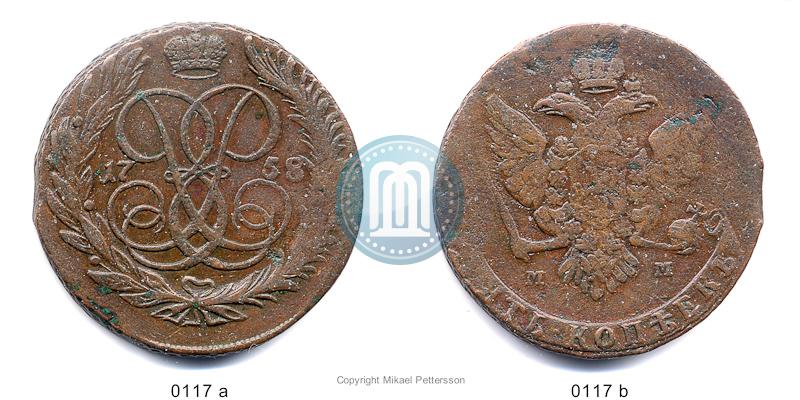
-
I love your coins, Sigi. The last two are featured in my catalog to represent the types, as you know.
 (along with some of your other coins)
(along with some of your other coins)
The first two SM scrolls (type II and III) are related. It seams that type III was "carved" out of type II. That could possibly be the very first scroll to appear on 5 kopecks at all (as SM production was kicking in first, I assume). It is a mystery to me why they decided to shave the scroll down and why there are so few coins with the scroll type II. Perhaps the side of the right scroll end was damaged on the coin model and they had no other choice, but to shave it down, "carving" the new type of the scroll out of it, salvaging it, and transferring it to the master dies. That would at least explain why the details of scroll type III are always so "sketchy" on the coins. It was always hard to believe that they made nice coin all around and didn't care much for the scroll ending on SM coins. Didn't make much sense... I originally thought that type III came from type I, but they seam disconnected compare to type II.
Note, that later SM type IV always goes in combination with the "copper" eagle (without an asymmetrical right wing) known only on SM.
-
Waiting for it in the mail excitedly. Just managed to secure it for a reasonable price.
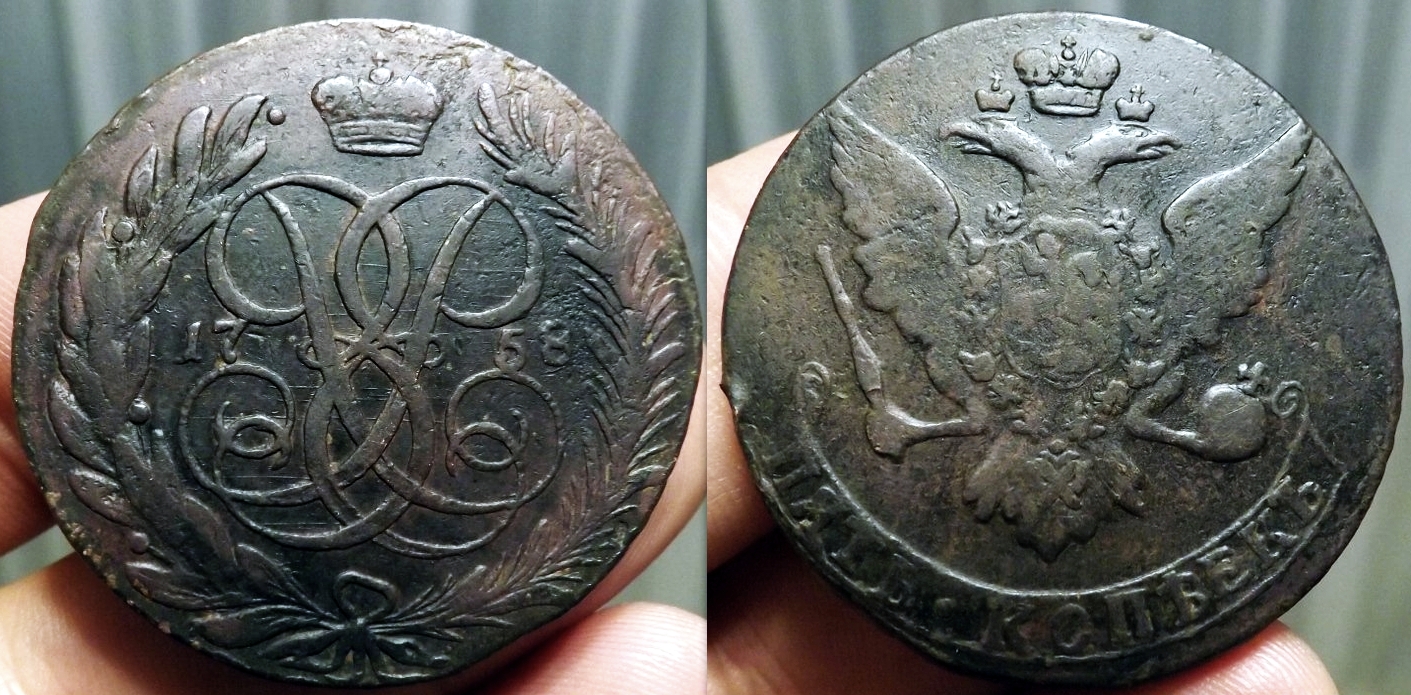
Only 4 coins with this scroll are known to me (all SM and from the same die pair). I have one in a low grade already in my collection and this is a second of the collectable grade coins that I've seen. The first one is here: https://www.m-dv.ru/catalog/p,199544/image.html
I am wondering if you can check your 1758 pyatak coins and try to find another coin with similar scroll ends. Similar request on Russian forums in different times didn't bring any new results. In order to understand what is so different about scrolls on this coin I'm posting a small diagram below that hopefully will be able to help:
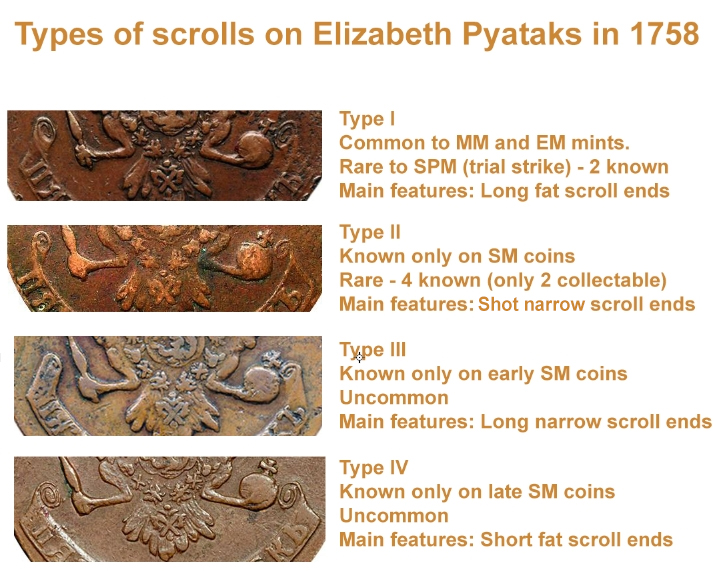
-
Included Sigi's coin in the topic I started on SM (modern pictures of coins from corpus of Russian coins): https://translate.google.com.au/translate?sl=ru&tl=en&js=y&prev=_t&hl=en&ie=UTF-8&u=http%3A%2F%2Fwww.staraya-moneta.ru%2Fforum%2Fmessages%2Fforum14%2Ftopic203750%2Fmessage2168167%2F%3Fresult%3Dreply%23message2168167&edit-text=&act=url (translated to English version), here is a link to original Russian version: http://www.staraya-moneta.ru/forum/messages/forum14/topic203750/message2168167/?result=reply#message2168167 Now Sigi's coin can be shown in a company with coins from GM and Hermitage collections.
 If you have more modern images of coins from corpus, happy to add them to the topic, if you supply them.
If you have more modern images of coins from corpus, happy to add them to the topic, if you supply them.
-
Would you like to send large images to my email, I can post them on my web-space and post them here for you?
-
It's an amazing find Sigi! I can imaging the spectrum of feelings that you went through when you found it, won at the auction and finally got it and held it in your hands for the first time... There is nothing like this hobby, when you can feel at the same time as a historian researcher, an addict and a treasure hunter! Well done finding it and securing it for a hansom, but way under its real price (if you really know what it is). My honest congratulations!
-
The world is full of wonders...
 Check here: http://numistika.com/counter ivan.html
Check here: http://numistika.com/counter ivan.html
-
Agree. Also, can you please ask questions in general area( http://www.coinpeople.com/forum/11-russian-coin-forums/ ), this area is for articles.

-
I can only assume that cradles or containers with coal were brought to the Petersburg factory for a redistribution to the local public, to keep their houses warm in cold seasons. Public members paid at a reception and got a token to say how much the workers, who redistributed coal, were suppose to give them in exchange for that token, with a box of some kind being a standard measure in this case. I remember one of my grandmothers used to live in a city, in house that was warmed by coal burning, and it felt very cozy. My dad would buy coal in full, 3/4 or 1/2 track loads in summer for her to use in winter. I think here we had a similar story.
-
Looks like "Petersburg Factory - 3/4 box of coal - 1772". Correct me if I'm wrong. Very similar to plate money.

-
Here is another interesting ?token (?coal coupon)
-
Thank you!
 I will. They also had big ties with Americans after Russia withdrew it's advisors...
I will. They also had big ties with Americans after Russia withdrew it's advisors...
-
It is certainly addictive
 ...
...
You are right, it is the die clash! Well spotted.

How many mints worked, producing coins with machine press, around 1895-1999? What was the movement of the equipment?
-
I'd like to continue exploring old Korean coins. This interest comes from the thread in Russian section, that was the only section on the forum that I'd ever visited:
I am fascinated by Russian overstruck coins, and I was pleasantly surprised to find that Russian drive to overstrike coins was not restricted to Russia only, and that other countries were affected by this drive just as well. After reading and researching Korean coins of the last king and the first emperor of Korea in one person, I know now that some of Korean coins were struck over in China to produce CASH coins, etc.
Gxseries have shown a few examples of those in his previous posts in this section of the forum (just search "Korea 5 fun")...
However, I haven't found anything on Korea striking coins over with the new image. I don't know if that has ever happen, but I just found one example of 5 FUN 1986, that may as well be a restrike to correct error, which I still find very interesting.
Can anyone show me any other examples of Korean old coins with machine restrikes / overstrikes?

-
6 hours ago, gxseries said:
extant4cell - I think at this point of time, it's hard to pinpoint where this coin was produced. The denomination "dollar" does not make any sense whether it was produced by the Koreans, Japanese or Russians. Again, I think it's a bit too early to dismiss anything. BUT - if I had to throw in an absurd theory, it could even be a pattern by the British. They did produce so many coins around the word - it would not be a surprise if there are some undocumented examples. It's only quite recent that a fair number of highly prized Chinese pattern coins appeared in the market that were indeed produced by the British and they were struck around the same time frame.....
Thank you for the reference material, gxseries! I'll read it tomorrow now. Deep night now... I got too excited learning about Korean coins, that forgot to sleep. Anything is possible, when it comes to the origin of these coins, but with different degree of probability. I will not be surprised if the Gwangmu had some Russian help in designing the CoA for the coin. Thank you, again, for an interesting topic.

-
Now, coming back to the coins under king and emperor Gojong.
To understand the dating of Korean coins we need to look at a long list of rulers of Korea (https://www.metmuseum.org/toah/hd/koru/hd_koru.htm), and particularly at a dynasty that Gojong belonged to, Joseon. The dynasty ruled from 1392 (year 1 of the rule) to 1910 (year 519 of the rule). Which makes 1893 the 502 year of dynasty rule.
The Korean numbering system goes something like in these tables:

As we can see numbers are represented by (mostly) single "syllable" words, that are based on Hangul - Korean own phonemic system of writing. And it is reasonably easy to read them. Let's say CHIL (7) - it is easy to recognize letters that represent CH - I - L ( ㅊ - ㅣ - ㄹ ) grouped together into single syllable word 칠 .
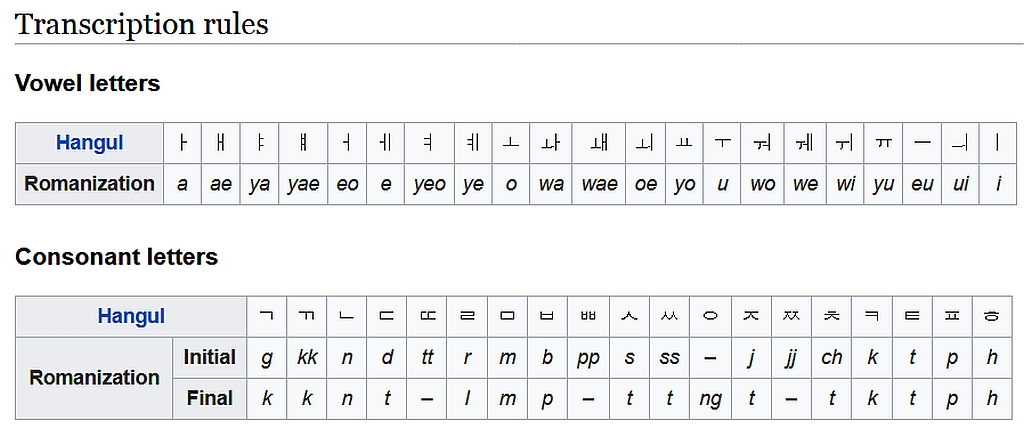
Year 503 = 오백 삼 in that system (Five - Hundred - Three). Seams easy enough...
But, you didn't think it would be that easy, did you? The above is the number system that is used for recording year, money (at present), time etc. This system is called Sino-Korean system, which is said based on Chinese system, in which way though, I still do not understand, as numbers in Chinese sound and look differently, but lets take this statement at face value for now. The other system is Native-Korean system, where own Korean words for numbers are recorded also using Hangul, and that's where it becomes a little confusing. See tables below:

For example, SEVEN in Native-Korean system is "ilgup", which starts with syllable "il", which in its turn is also a number "1" in Sino-Korean system. I guess, if you Korean, it is natural for you to know when to use which system, so they don't mix it as much, but for outsiders, it is more challenging to understand. Now, let's compare this system to Chinese numbers:

They look and sound nothing like the numbers in Sino-Korean system (that's why I still don't understand how they are related), but look simple enough to follow. And what have we got on Korean coins? Let's see. Here is an example of King Gojong coin (1893 or year 502 of dynasty rule) from before:

So, the 3rd, 4th and 5th symbol on the top, though appear upside-down (it's easier to read it when coin in hand and you can move it along the reem), represent the number 502 (five-handred-two) in Chinese number system, the number of the years this dynasty ruled up to this coin production year, which makes it 1893. And the very last symbol 年 represents "Year". Here is a corresponding table, for other coins year conversion:
502 - 1893 506 - 1897 510 - 1901 514 - 1905
503 - 1894 507 - 1898 511 - 1902 515 - 1906
504 - 1895 508 - 1899 512 - 1903 516 - 1907
505 - 1896 509 - 1900 513 - 1904 517 - 1908Though, there was probably no need to go as far as 1908, as I think that since the assumption of the new title of Emperor, the counting started from anew, and 1897 becomes year 1, instead of 506.
After that I managed to find one translation of what it says on the coin above:
Obv: Korea Founded 502 years ago 5 Pun (Fun);
Rev: 5 Fun (with easily recognizable Chinese number 5 - 五 and hieroglyph 分 - meaning "fraction" or, I think - smallest part of money possible, in case with Korea it is FUN)At first I thought that translation on obverse "5 Pun" was related to the "5 Fun" written in Latin (English) letters.
You can imaging how upset I was to find out, after my exciting exploration of Hangul, that Hanja still prevailed on coins, with Chinese hieroglyphs and Numbers, at that point in time!
But as I noticed a few posts above, that the last two words on the right of obverse were the same on 5 Fun and on 1/4 Yang, if you remember I wrote: "5 Fun have the same hieroglyphs as the last 2 hieroglyphs in 1/4 Yang. So, can I assume that 5 Fun would equal 1 Yang at that time, or the last character represents a different denomination all together, like Chinese Cash coin, or something else, and the first hieroglyph(s) represent different from numeric fractions (let’s say a fraction of a measurement of grain)? " Of cause I was wrong, but amazingly, I was on something there.
I played with Google translate a little, and yes, I deciphered it as Sino-Korean Number 5 (오) and Hangul spelling for Pun (푼) that I decipher as phonetic sounds ㅍ – P(h), ㅜ - U, ㄴ – N, grouped together according to Hangul system of writing into a single syllable word.
So, after all, Hangul was present on these coins!!! These amazing coins managed to have Hanja (Chinese) hieroglyphs combined with Chinese numbers, with Sino-Korean numbers and Hangul system of Korean writing, and to top it up - Latin interpretation of the value of the coin with Arabic numbers. No wonder it is hard to understand what is written on these coins, as you would have to be a Korean, trust the already provided translation or explore it.

So, why does it repeat "5 Pun" (the last 2 syllables out of 4: 두 돈 오 푼 [on coin they are read right to left]) on 1/4 Yang coins? This is easily explained if you look into it. What it actually says is: " 2 Chon 5 Pun", the meaning of that is basically "Couple of Money peaces and 5 Smallest Fractions". You see, in Korean system 10 Chon (money) = 100 Fun (Fraction) = 1 Yang. Subsequently, 1/4 (0.25) = 2 Chon and 5 Fun (2 money and 5 fractions). Interestingly enough that here number 2 is represented not by "EE" - 이 - that means 2, but by 두- "DU" - what means couple, and comes from 둘 "DUL" in Native-Korean number system, by the look of it.
Chinese hieroglyph 開 - "open", and 國 - "country" before the year numbers can by interpreted as "country's foundation".
And finally, the first two hieroglyphs in Chinese mean 朝 - reign (also may mean "towards" or "morning", but in Japanese it means "dawning" or "morning"), 鮮 - fresh (also may mean "few", "rare", "little"). So, together these two hieroglyphs 朝 鮮 could mean "new dynasty", but in Chinese, Japanese and Korean combination of these two hieroglyphs have one persistent meaning - Korea, and it has a very long history. Though, looking at the coin and seeing symbolism of the meanings separately (morning, fresh, open and country) it is understandable how someone arrived at the alternative, poetical form of the name for the country: Land of Morning Freshness. The name 朝 鮮 was first recorded by Chinese in the 1st c. BC, and it was given to Gojoseon (ancient Joseon) and in Chinese sound something like Chaosyang. The actual name that we pronounce as "Korea" has nothing to do with the recorded name. It is derived from Joseon predecessors that can be described as Gojoseon, as any of the dynasties that happen before Joseon dynasty. But directly before Joseon there was Goryeo, and it is assumed that name Korea comes from it. It also sounds similar to Goguryeo (that somewhat sounds like Go-Gorueo [that would stand for ancient Korea]). Here is a short list of main Dynastic lines:
Three Kingdoms Period (57 B.C–668 A.D.)
Goguryeo
Baekje
SillaFollowed by Unified Silla Dynasty (668–935)
that coexisted with Barhae state (699–926)Followed by Goryeo (918–1392)
and finally by Joseon dynasty (1392–1910)
So, the name Korea, is derived from Goryeo, Joseon's predecessors.
Here is the list of value relationships as I understand it [for the period], and it's still incomplete (so I may edit it later):
1 Hwan = 1 Won = 5 Yang = 1 Japanese yen
1 Yang = 10 Chon (Don) = 100 Fun (Fen/Pun)
1/4 Yang = 25 Fun or 2 Chon 5 Fun
1 Chon = 10 Fun
1 Fun is a smallest denominationNow let's see a coin from 1898, I assume (2 years from foundation of the great Gwangmu Empire):
-8qMKbzbiXR0AAAFNtrltvw4S.jpg)
I'll try to decipher the new first 4 symbols. But it reads something like this: Great Korea, from Gwangmu foundation 2nd year, Two Don Five Pun
大 - Great, 韓 - Korea. Basically 大 韓 means Great Korean Empire; 光武 - Gwangmu is a new assumed name for the new dynasty of empire. The rest is the same as before.
From what I understand, horizontal system of writing is fairly new, and wasn't used then, only vertical, which resulted in reading from top-to-bottom right-to-left, so it should have looked something like that in written form:
1/4 두 光 大
Y 돈 武 韓
A 오 二
N 푼 年
G -
gxseries, thank you very much for your input. This is most interesting. Is the other side of the 1899 test coin available?
I respect your opinion, though, I would still disagree with the idea that the pattern test coin of 1899 with Korean Eagle (copied from Russian CoA) were struck in Russia. I can see the Korean emperor's drive to produce coins, that would proclaim Korea's independence, but I still see no benefit in doing so, for Russia, particularly that Russia had no control over Korean mint, it had Japanese staff.
According the Russian sources Russian military instructors and financial advisor Alekseev were recalled in spring 1898, and that coincides with information about Russo-Korean bank as mentioned by Keith L. Pratt and Richard Rutt, where it states that Russo-Korean bank was shut by the end of March 1898 after trading for less than a month (see link below):
In Apr.13 1898 comes the Rosen-Nissi Convention (to Korean dismay): Russia yields its dominant position in Korea to Japan...
Yes, I understand that mint had Japanese staff in it. But it was still Korean mint, and they had to do what was ordered by the emperor of Korea, and if it was his wish, expressed via his officials, to produce test coin like that, they may have reported it to Japanese officials, but would still have to make a test coin, or they may loose influence over the mint.
The coin itself, in my opinion displays the former Russian influence that was welcomed by Korean Emperor, in form of his choice of emblem, but also, Korean plea to America for help. St. Petersburg mint would NEVER put DOLLAR denomination on the test coin made in Russia. I am strongly minded about that. It would just be a sign of BAD practice, in my opinion. Of cause, I cannot prove it, just as much as you can not disprove it. We can keep true to our viewpoints until one of us is proved wrong. The above presented coin descriptions from Heritage are only based on speculations that were used to provide basis for invasion by Japan in 1905, in order to "keep peace".
Appointment of Yi Yong-ik as the Minister of Treasury in 1901 may explain the further drive in coin changes to reflect emperors independence proclamation. Yi Yong-ik was rather the emperors man, than a pro Russian figure, as emperor himself can be called that, as he was seeking Russian protection of Korean (and his family) independence, the hopes of which went down with the flames of a lost Russian fleet in 1905.
As additional information, here is a background of Russo-Japanese war: http://cnparm.home.texas.net/Wars/RusJp/RusJp01.htm
-
I am still fascinated by this topic, and would like to know a bit more about these coins, and the language used on them. Here is what I found out, so far.
There were two systems of writing used, and partly used till now. Hanja that uses Chinese hieroglyphs, and that all ancient Korean manuscripts are written in. And a new, system that is original Korean development of XV c., called Hangul (Kor. 한글) - a phonemic system of writing where letters are grouped into syllables-like groups. Here is an example of how different letters of the word "HANGUL" are put together into syllables-like groups, which in turn somewhat resemble hieroglyphs:

It's alphabet (kanada) has 28 letters (that start with letters ka-na-ta). Until now, the Korean (Hongul) alphabet continues to amaze researchers with laconicism and orderly forms. The Hangul Korean letters sometimes are called the only original alphabet in the entire Far East, which had a huge impact on the grammatical thought of China and Japan. Little wonder that Hangul, as a phonetic system of writing, was described as a the standpoint of the philosophy of Yin and Yang and the harmony of vowels.
However, until the start of XX c., Hangul was hardly ever used in the literature and was looked down upon by those who were writing learned works. Instead, they used Hanja system of writing that was based on Chinese hieroglyphs. Here it says it's name in Hanja logo-graphical hieroglyphs (in red) and the same word (Hanja) in Hangul (in blue):

Presently, Hangul is the main system of writing with Hanja hieroglyphs still used for Chinese based words, which is probably half of Korean lexicon. However, Chinese based Hanja is usually used only as a guide for the meaning.
I can relate to that very well, as English isn't my first language and pronunciation isn't my greatest of skills, I still speak with a heavy Russian accent. When I was learning English, I would typically transcribe pronunciation using Russian letters, so even till now my pronunciation of words such as: Work, Walk, Wok is pretty much the same and their vocal equivalent of Russian transcription would be something like "Vok". So, if I'd say any of these words out of the context it may be hard to understand what I mean (which "vok" I am talking about).

Similar thing is happening in Korean language. Different Hanja (Chinese) hieroglyphs can sound the same, but mean different things. However in Hangul, hieroglyphs with different meaning that sound the same way, would be written down exactly in the same manner when Hangul is used. To rectify this problem, Hanja hieroglyphs are provided next to some words written in Hangul, where the meaning may be ambiguous, just as a guide.
So, to sum it up, Korea has a complicated system of writing which still doesn't allow Korean language to shake of Chinese influence completely, and I don't know if it seriously matters much to Koreans or not, just noting this down.
At the end of the XIX century, Hangul became a national symbol as a national protest against Japan's attempts to spread its influence on the Korean peninsula. As a result of a reform Hangul first appeared in official documents in 1894. Here (see under "Transcription rules") you can learn more about Hangul "syllable" group formation and what Korean single characters look and sound like, which actually changes depending on a leading or closing position in the Hangul "syllable" group: https://en.wikipedia.org/wiki/Revised_Romanization_of_Korean
What really was important to me, apart from that the above thing is quite fascinating, try to understand what it says on Korean coins we looked at earlier. Let's m see if I can actually do that. I bet not all of my guesses about what it says on the above coins were right, which I would really expect.
-
Can I also ask if all 3 coins, that you mentioned in the first message are all the same (3 half dollars) or did you mean 1 Chon, 5 Chon and Half Dollar?
And which catalog did you find it in?
-
So, let's see what we have on the market.
Information for reference:
Gojong (Hangul: 고종; Hanja: 高宗; RR: Gojong; MR: Kojong), the Emperor Gwangmu (Hangul: 광무제; Hanja: 光武帝; RR: Gwangmuje; MR: Kwangmuje; 8 September 1852 – 21 January 1919), was the twenty-sixth king of the Joseon dynasty and the first Emperor of Korea.
Ruled as a King of Joseon from 13 December 1863 to 13 October 1897
Became an Emperor of Korea on 13 October 1897 and ruled till 21 January 1907Here is an example of King Gojong coin (1893):

One thing worth mentioning is that during the ruling of King Kojong a mechanical press was introduced to coin minting.
I had a look from 1894 onward. 5 Fun coins dominate the market over 1/4 Yang, but both (in bronze) are present in 1895, 1896, along with 1 Fun. In 1897 it looks like there was some interruption in coin production, with some rare 1/4 Yang listed in the catalog, but I never seen it. Which is hardly surprising, as in 1897 Korea went through unsettled times, with the King becoming the Emperor.
In 1898 5 Fun (bronze) and 1/4 Yang (now in bronze and in nickel) both equally dominate the market, with 1 Yang also listed in catalog. It looks like in 1899 there was yet another interruption to coin minting and I could only find one coin, 5 Fun, that is very expensive at US $5,999.99 in VF25 condition available on the market. Here are their examples:

Looking through the past sales reviled that both 5 Fun and 1/4 Yang coins were still produced in 1899, but in small quantities and that both are very rare now. Here is example of 1899 1/4 Yang:
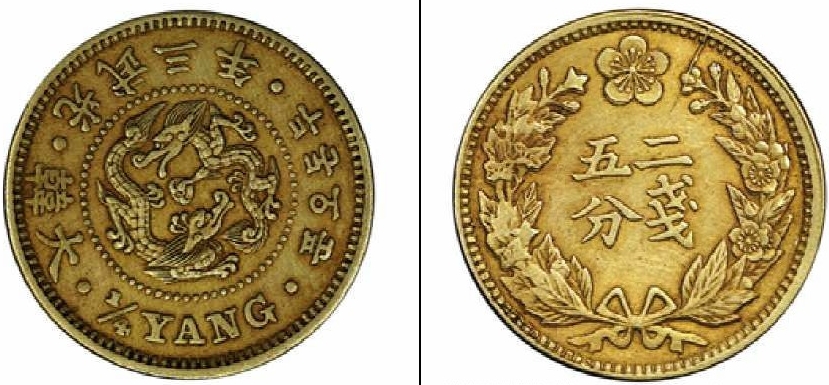
In 1900 and 1901 I could find only one coin for each year in the past sales (in copper-nickel and in nickel), both extremely rare:


There is nothing on the market up to 1902, when 5 Fun returns with (look at that!) the new CHON denominations:
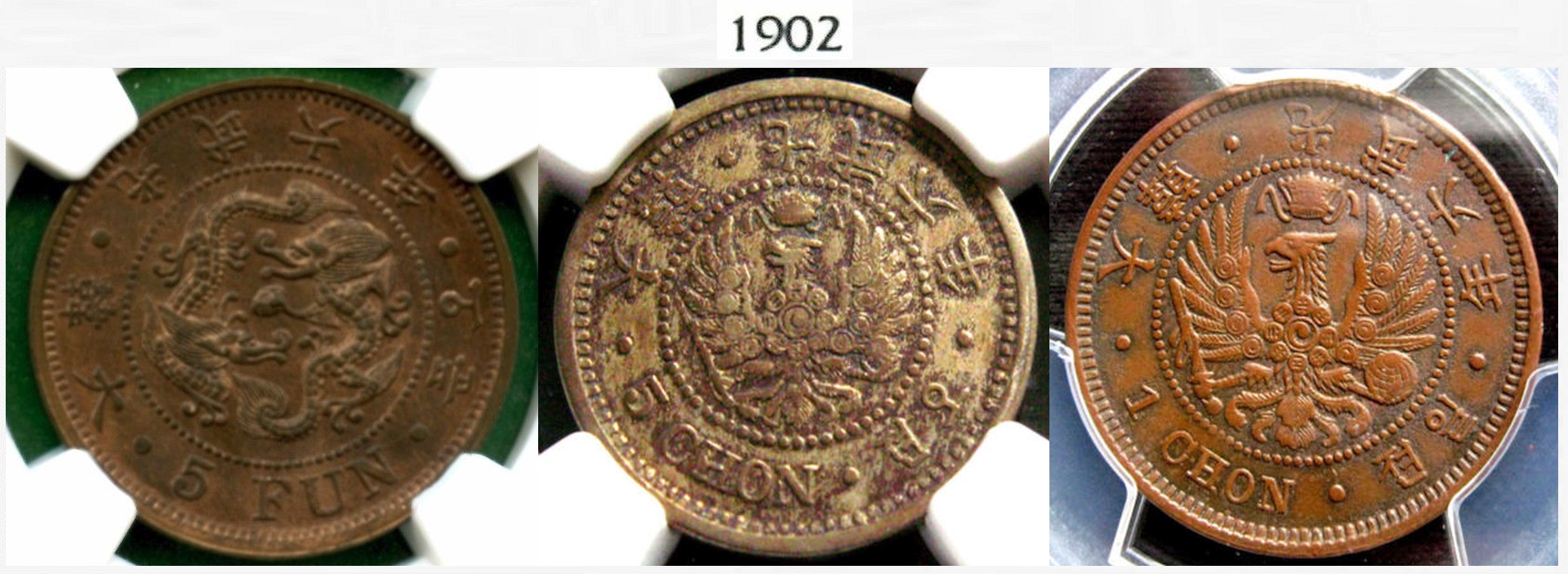
The new Korean Chon coins resemble the Half Dollar, from 1899, that started it all, so much! It's using the same eagle. By 1902, as you know Russian presence in Korea is minimal, and I guess the King liked the design of the new coin presented to him in 1899, so it finally finds it's way to the market, along with a new denomination. Who presented the half dollar coin to the emperor in 1899 stays unknown, but I don't believe that it was Russians.
I was even tempted to buy 5 or 1 Chon coins, to remember this little research, but the price between US$6,500 and US$16,000 repelled me from doing so for now. They are very rare too. With 5 Chon making past appearances a few time more than 1 Chon.
Unfortunately, it was a short lived appearance. Reappeared "Russian influence" didn't find it's permanent place on Korean coins. In 1903 there is another interruption to the coin production and 1904 brings no return as well.
Korean coins return to the market in 1905 with a new Half WON denomination and with a new 1, 5 and 20 CHON design under Japanese protectorate. Korea again finds new more Asian form of emblems placed on their coins (Chinese / Japanese influence?). Though it was a lot of FUN to see "Russian" eagle on Korean 1899 (pattern [I guess]) and 1902 regular strike coins.
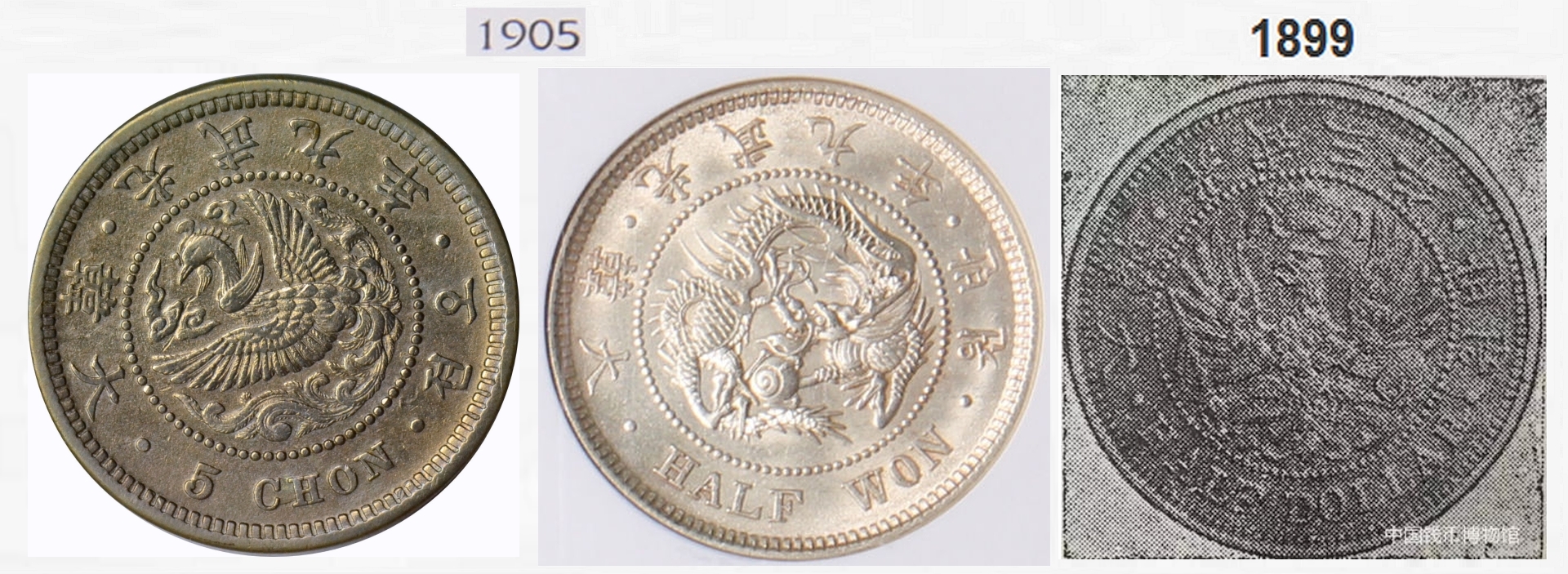
I have no patience at the moment to count the dots around the emblem, but to the naked eye 1902 5 Chon and 1905 Half Won look very similar to the 1899 coin.
I guessed that the top 4 (or however many) hieroglyphs represent the year (of the rule), as they are the same on 1899 Half Dollar and on 1899 5 Fun. The left 2 hieroglyphs represent emperor or dynasty (as they change with the change of the ruler).
And, finally, the 2 (4) hieroglyphs on the right must represent the denomination (1, 5, half, represented by 1 hieroglyph, while 1/4 represented by 3 characters). Interestingly enough that (see 1898/1999 picture) 5 Fun have the same hieroglyphs as the last 2 hieroglyphs in 1/4 Yang. So, can I assume that 5 Fun would equal 1 Yang at that time, or the last character represents a different denomination all together, like Chinese Cash coin, or something else, and the first hieroglyph(s) represent different from numeric fractions (let’s say a fraction of a measurement of grain)?
Another interesting thing is that 1899 Half Dollar becomes Half Won in 1905! The 2 hieroglyphs on the right are absolutely the same!

So, there we go. The 1999 Half Dollar with Korean Eagle in the end reincarnates into 1905 Half Won under Japanese protectorate, with Dollar becoming Won. The history of this little country is amazingly represented in its coins, and that's where it is interesting to be a numismatist.
The above is just my thoughts, based on coin analysis.
And finally, I absolutely agree with you, gxseries, as I already did above, that Korean Eagle was heavily influenced by Russian Empire CoA. It is particularly apparent if to place Russian eagle and Korean eagle from the 1902 1 or 5 Chon coins next to each other - a complete resemblance:

And here are some cherries on the cake, some pattern or possibly "novodel" coins that I found after I thought I finished with this, so I am editing this post to add them along with some additional information:

(coin is enlarged for better viewing experience, in reality it is a very small coin)
Here is its description from 2011 September Long Beach Signature World & Ancient Coins Auction:
"Russian Domination, Kuang Mu copper Pattern 10 Won Year 7 (1903), Unlisted in Krause (although NGC has listed this as KM-Pn34, that is incorrect, as Pn34 is Year 5, and this piece is Year 7) and the The Catalog of Korean Coins and Banknotes, Russian eagle/Value in wreath, MS64 Brown NGC. Listed in J&V as AC3. Well struck, with traces of mint red color around the devices. The only flaw worthy of mention is a dark spot in the right reverse field. This is the only example of this Pattern for a Russian influence 10 Won gold coin that we have ever offered, or seen for sale in a previous auction Increased Russian influence in Korea from 1896-1904 resulted in three types of regulars issue coins being struck in fairly large quantities. Few of these were ever released, and very few survive. This Russian threat was eliminated by the Russo-Japanese War in 1904-05, and Japan maintained a protectorate in Korea until after World War II. No gold coins were struck during the Russian domination, and this example and the following 20 Won Pattern, are the only two examples of coins struck during this period meant as possible gold coins." (I couldn't find 20 Won picture with Korean eagle)
Similar description was given to this Half Won 1901 coin:
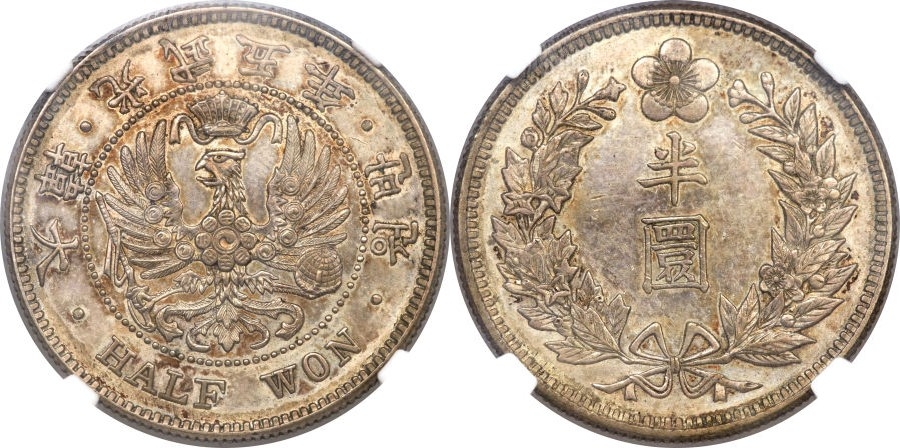
"Piedmont Collection, Korea, Kuang Mu Russian domination silver 1/2 won year 5 (1901), Crowned Russian Imperial eagle, with orb and scepter, in circle/Value in wreath, SCKC-41.1, KM-1123, Choice BU with a few very light reverse hairlines. An extraordinary example of the rarest of the Russian influence types. Increased Russian influence in Korea, from 1896 to 1904 resulted in three types of coins (1 chon, 5 chon, and 1/2 won) being struck with a Russian eagle in place of the Japanese style dragon. After the Russian threat was eliminated by the Russo-Japanese War (1904-05), Japan established a direct protectorate over Korea. Japan maintained this direct control until the end of World War II."
With one Half Won appearing in 2000, another one in 2006 and yet another one appearing in 2013. All coins were sold via Heritage Auction, what some may think is a little fishy, as now one may predict for another coin to appear at Heritage Auction closer to 2020.
Where it comes to "Russian threat to Korea" in coin descriptions, I find it a little off the marks, and too prejudice towards Russia, though the myths should find their beginnings somewhere, and it is quite expected...
What do you think?
Images from eBay.com and www.acsearch.info were used above.
-
Gxseries, thank you for this interesting topic. Numismatics is a branch of historical discipline, after all, and it was exciting to look into all of this...

Very interesting reading about the "country of the morning freshness", as it was poetically called by Chinese, before it's call for independence. There is very little information about the actual eagle. I could only find the "golden"' version of it, as you presented above, in Wikipedia, named as an imperial symbol and pictured next to imperial seal of Plum blossom, with no comments or references. Someone recently even made an effort to color it in in "Russian" colors, to make a point that it has Russian origin.
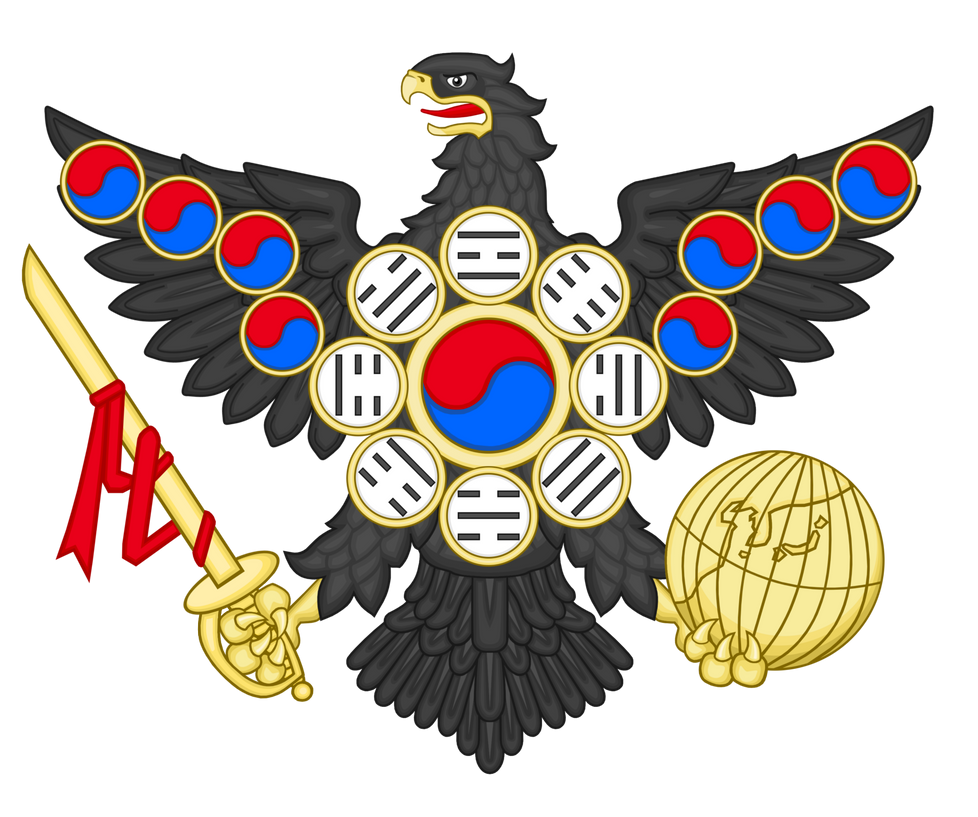
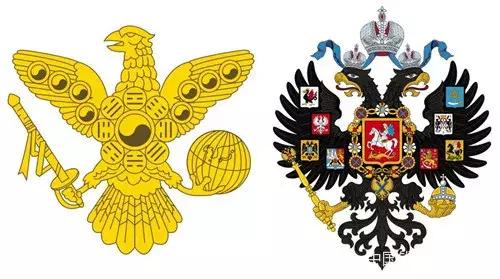
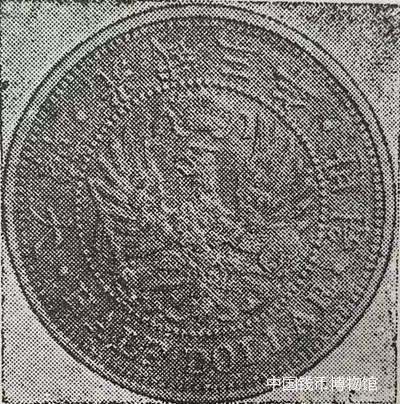
In the article you provided above and in other sources, wherever I read in the last 24 hours, on the history of Russian and Korean relationships before the revolution, it clearly states that USA in alliance with GB on one hand, and Japan on another, were the largest stake holders in Korean politics after China withdrew its influence, and so the above mentioned influenced the country in their own ways, as their had little success in influencing the royal family that obviously wanted independence. The royals had little control over the country, due to absence of loyal military structure that alloyed Japanese and others to come and go, as they pleased, solving their problems with force. This resulted in kinds of upheavals in different parts of that nation, disturbing the peace, and eventually lead to assassination of the Korean Queen by Japanese in the royal palace. That actually turned the Korean royals towards closer ties with Russia, that Russia welcomed.
Relying on the strength of Russian guards, Korean king turned to Russian diplomatic mission in seeking safe haven, and was provided with a roof over his head for about a year. Where he ruled the country from. He refused to return to the palace in which the queen (his first wife) was assassinated by Japanese ronin. In that time a new palace was build in close proximity to Russians.
The Korean royals were invited to represent themselves at Nicholas II coronation, and after that were provided with some military and financial advisors / assistance. Since Russia now had a common boarder with Korea, it was important to Russia to trade with it and to assist Korea with peace keeping in order to grow its economy. That included establishment of Rosso-Korean bank and resulted in Russian business receiving some privileged concessions.
That may explain the Russian influence on royal choice of their symbol. Although, to my liking the first two representations above are too simplistic, and it probably looked just like on the coin that you've shown.
Though, documented reference would be the best source of confirmation, I think it is safe to assume that the eagle symbol was actually adopted as the royal choice that could represent the Korean king's assuming the title of Emperor, as Russia made a very deep impression on the king as a great empire that was worth of copying from.
In 1898 Russian advisors were removed from Korea, in order to please the "opposition" of the royals and in order to have peace in internal affairs. But first, Russia and Japan signed an agreement to let Korea continue its independence, while both parties were to keep doing business with it.
It also states in the article, that Japan and USA both had about twice as much of registered Korean immigrants on their territories, compare to Russia, and continued influencing different layers of the nation in order to overthrow the government and to take control over it. To ease the growing unrest, Russia withdrew the advisors with Korean royals permeation, as stated above, in 1898. As I wrote before, Russia had plans to concentrate more on Manchuria, and after withdrawal of its advisors provided little help to Korea, even when requested, though it kept diplomatic and business presence. It had no intention in ruining relationships with Japan or America.
In light of the above, it is more likely to me, that this coin (given it is an authentic coin):

has nothing to do with Russia at all, but with America trying to influence Korea economically, and possibly, providing assistance in upgrading Korean mints (perhaps providing them with new presses?). The royal symbol (ironically Russian in origin) was used simply to represent the royal imperial power, aiming at pleasing Korean Emperor, as it was his choice of emblem.
I also have HUGE doubts, as I mentioned before, that be it a Russian coin in origin, that DOLLAR system and English language would not be used by Russian mint designers. They would probably use the local currency system. Though, it was only customary issue the coins for Russian protectorate territories in double system, local and used in a Greater Russian empire, like in Poland and Finland, for example. I have even greater doubts that Russian emperor would risk being accused of having invasion plans, just by minting a coin like that...
Once Korea became independent it turned from using Japanese influenced Korean YANG system and replaced it with own Korean FUN system. I am no specialist in Korean coins at all, so I turned to the market, to see what is available in that period. Let's see what I found (still in making), in the next post.

-
Thank you for additional information! I am still a little puzzled in which way Half Dollar coin may be of Russian influence. Would it be Half Rouble or a Double Headed Eagle, it would be self-explanatory, but Half Dollar would hardly call for Russian influence, more like American influence, or am I missing something?

I already posted the topic, while I was at lunch. I am unable to access that site in Russian (due to sanctions?! LOL), but can see it when translated to English via google. Not a perfect translation by google, as always, but good enough,
 and English is just what we need:
and English is just what we need:



Finally found 2 kopecks 1757 SPM nominal above - very poor
in Russian Coin Forums
Posted
It's a very poor condition coin, but even that one took me over 5 years to find, looking through tonnes of coins on sale at various places, including Russian "eBay", where I finally found this one. The main features are that of a crown, numbers and most of all the above nominal letters and dots. The last letter in the word "копейкИ" should be very close to the St.George image and the horse's leg almost touches it. And naturally it must be an overstrike from 5 kopecks to 1 kopeck SPM (СПБ) and finally to 2 kopecks 1757 with nominal above and reticulated edge. If you may have a better coin in your collection, please show. I've only seen 2 other coins SPM, with this been in the poorest condition, I think.